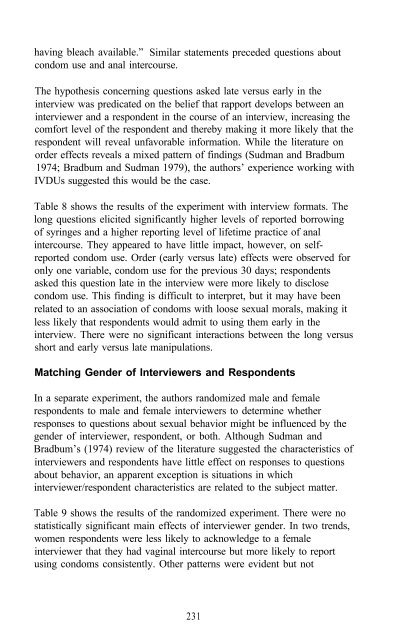The Context of HIV Risk Among Drug Users and Their Sexual Partners
The Context of HIV Risk Among Drug Users and Their Sexual Partners
The Context of HIV Risk Among Drug Users and Their Sexual Partners
Create successful ePaper yourself
Turn your PDF publications into a flip-book with our unique Google optimized e-Paper software.
having bleach available.” Similar statements preceded questions about<br />
condom use <strong>and</strong> anal intercourse.<br />
<strong>The</strong> hypothesis concerning questions asked late versus early in the<br />
interview was predicated on the belief that rapport develops between an<br />
interviewer <strong>and</strong> a respondent in the course <strong>of</strong> an interview, increasing the<br />
comfort level <strong>of</strong> the respondent <strong>and</strong> thereby making it more likely that the<br />
respondent will reveal unfavorable information. While the literature on<br />
order effects reveals a mixed pattern <strong>of</strong> findings (Sudman <strong>and</strong> Bradbum<br />
1974; Bradbum <strong>and</strong> Sudman 1979), the authors’ experience working with<br />
IVDUs suggested this would be the case.<br />
Table 8 shows the results <strong>of</strong> the experiment with interview formats. <strong>The</strong><br />
long questions elicited significantly higher levels <strong>of</strong> reported borrowing<br />
<strong>of</strong> syringes <strong>and</strong> a higher reporting level <strong>of</strong> lifetime practice <strong>of</strong> anal<br />
intercourse. <strong>The</strong>y appeared to have little impact, however, on selfreported<br />
condom use. Order (early versus late) effects were observed for<br />
only one variable, condom use for the previous 30 days; respondents<br />
asked this question late in the interview were more likely to disclose<br />
condom use. This finding is difficult to interpret, but it may have been<br />
related to an association <strong>of</strong> condoms with loose sexual morals, making it<br />
less likely that respondents would admit to using them early in the<br />
interview. <strong>The</strong>re were no significant interactions between the long versus<br />
short <strong>and</strong> early versus late manipulations.<br />
Matching Gender <strong>of</strong> Interviewers <strong>and</strong> Respondents<br />
In a separate experiment, the authors r<strong>and</strong>omized male <strong>and</strong> female<br />
respondents to male <strong>and</strong> female interviewers to determine whether<br />
responses to questions about sexual behavior might be influenced by the<br />
gender <strong>of</strong> interviewer, respondent, or both. Although Sudman <strong>and</strong><br />
Bradbum’s (1974) review <strong>of</strong> the literature suggested the characteristics <strong>of</strong><br />
interviewers <strong>and</strong> respondents have little effect on responses to questions<br />
about behavior, an apparent exception is situations in which<br />
interviewer/respondent characteristics are related to the subject matter.<br />
Table 9 shows the results <strong>of</strong> the r<strong>and</strong>omized experiment. <strong>The</strong>re were no<br />
statistically significant main effects <strong>of</strong> interviewer gender. In two trends,<br />
women respondents were less likely to acknowledge to a female<br />
interviewer that they had vaginal intercourse but more likely to report<br />
using condoms consistently. Other patterns were evident but not<br />
231
















